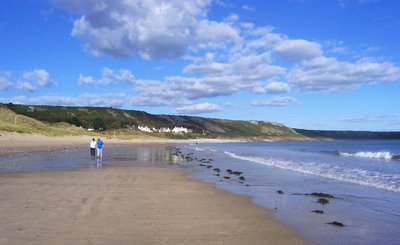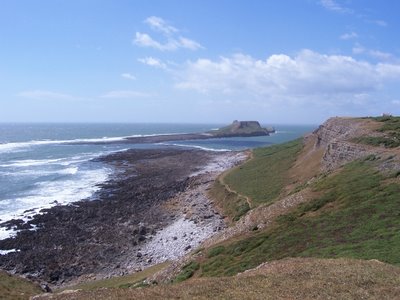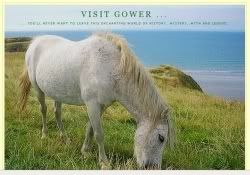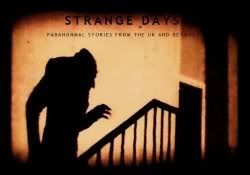Today, Monday October 15th, 2007, is international Blog Action Day. This year's theme is the environment, and the aim today is to get thousands of people across the globe blogging on this one theme. By joining Blog Action Day, I have the opportunity to publicise an issue which is of utmost concern to me, and many thousands of other people. I refer to the controversial issue of sand dredging, which is carried out along the Gower Peninsula's famed and beautiful coastline.
Gower lies just west of the coastal city of Swansea, in south-west Wales, and was designated Britain's first Area of Outstanding Natural Beauty (AONB) in 1956. Famed for its stunning beaches, windswept cliffs, ancient monuments, historic buildings, as well as the diverse flora and fauna of its unique eco-system, Gower is just 24 km long and 8 km wide. Once reliant on agriculture, fishing and limestone quarrying, since the decline of these industries, many local people have found a new source of income - the tourist industry. Sadly, their golden panacea is under threat, along with the golden sands of Gower. Large scale, commercial marine aggregate dredging commenced off the Gower coast in 1964, focusing on the Helwick Bank, a sand bank which spans part of the South Gower coast, between Port Eynon and Worm's Head. Marine aggregate dredging provides materials for the building trade.

The Helwick Bank lies roughly 1 km off shore at Port Eynon, and 4km off the shore of Worm's Head. An estimated 750,000 tonnes of sand was removed from the bank between 1964 and 1993. However, commercial dredging intensified in 1993, and ever since, at least 100,000 tonnes of sand has been removed each year, by Llanelli Sand Dredging Ltd. This increase in dredging has coincided with massive sand loss from the beach at Port Eynon.
This is how Port Eynon's beach looked in the 1960's, a typical sandy beach, beloved by generations of holidaymakers and daytrippers.

This is how it looks today. Yet the dredging companies are adamant their large scale plundering of sand, a finite source, is causing no damage to Gower's sensitive and important coastal environment.


I'm no scientist, but as a law school graduate, I would say this is a case of res ipsa loquitur - the thing speaks for itself. Studies suggest there is some eastward drift of sand along the Bristol Channel, which most of Gower borders. However, since the mid 1990's, there has been unprecedented loss of sand from many beaches, with Port Eynon suffering the most.
The sand loss was already very apparent in 2001, when the Welsh Assembly government agreed to renew dredging licences relating to Gower. To add further insult to an already grave injury, the dredging companies recently applied for a renewed licence, to extract up to 300,000 tons of sand per annum, over the next 15 years. Llanelli Sand Dredging Ltd didn't get quite what they asked for. But despite a petition signed by more than 30,000 locals and visitors to Gower, the Assembly still granted a seven year licence, for the extraction of up to 150,000 tonnes of sand per annum. Where do they think this sand is going to come from? It's not as if it falls from the sky and can be quickly replaced. Sand takes millennia to form. The sand currently being plundered hails from prehistoric times. On the subject of prehistory, since the increase in dredging, the remains of a prehistoric forest are now permanently visible at Port Eynon.

In the past, this forest has only been uncovered for short periods, usually after sand drift caused by winter storms. It is now a permanent fixture at Port Eynon.
Llanelli Sand Dredging Ltd is a Dutch-owned company. The Netherlands does not allow any sand dredging to take place within 25 km of its shoreline. So why does the UK allow large-scale dredging just 1 km offshore? Not only is the tourist industry being harmed by such a rapacious plundering of Gower's sand, but even more importantly, the coastal environment is being damaged beyond repair. The flora and fauna of the Gower Peninsula is in serious danger of harm, or in some instances, possible eradication, due to depleted sand levels on beaches. Not only that, but what is large scale, commercial dredging doing to the fragile eco-system on the sea bed?
Sandy areas of the sea bed are essential spawning and nursery areas to many species of fish. They are also home to many burrowing species, as well as sea horses. Dredging also dislodges gravel and small pebbles, which provide shelter for many species. Until the advent of marine aggregate dredging, the sea bed off the Gower coast had been largely undisturbed since the Ice Age. If large scale commercial dredging continues, the sea bed's character will be thoroughly altered. This will have a severe impact on the eco-system, damaging the commercial fishing industry, not to mention the tourist industry, upon which many of Gower's people are dependent. Tourists like sandy beaches, not lunar landscapes.
So how exactly does dredging affect sand levels? Winter storms are known to draw down sand and shingle from beaches to offshore, so most sandy beaches seem a little depleted during the winter. In the summer, the weather is generally calmer, so sand and shingle once more accumulate and the beaches are replenished. However, marine aggregate dredging has the potential to disrupt this essential, dynamic relationship. When beaches suffer severe erosion due to offshore dredging, coastal defences, are also at risk. Sand dunes, sand cliffs, shingle beaches and salt marshes can be so badly damaged that severe coastal erosion occurs, such as that currently experienced at Port Eynon. Pobbles beach, next to the world renowned Three Cliffs Bay, has started showing signs of severe erosion over the last two years.

Until very recently, there was no break in the sand between the beach and the dunes. Now look at it.
The people of Gower and Swansea feel very betrayed by the Welsh Assembly government for allowing the rape of our beaches to continue. How much more environmental damage has to occur to our beaches, our sea bed, and our precious flora and fauna, before the evils of offshore sand dredging are halted? The building industry needs sand, that's indisputable. But why take it from so close to shore? Deep sea dredging is a viable, less pernicious alternative. If Gower's coastal eco-system and its dependent industries are to survive, this pernicious industry needs to be severely restricted and moved many miles offshore. Irreversible damage has already occurred to the Gower coastline. It is time to act now, and prevent further sand erosion, before our beautiful sandy beaches are gone forever.





1 comment:
Ah, but it costs extra to dredge in deep water and we can't have that can we?
These people get handed a licence to dredge money and erosion of their financial position would be unthinkable.
Incidentally, I used to work for the Glamorgan Naturalists' Trust so I am not disinterested.
Good article.
A.
Post a Comment